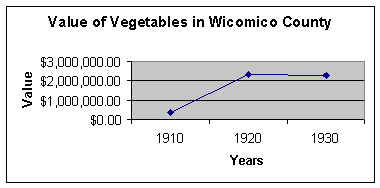
Chapter
Four:
The Growth of Canning in Wicomico County and its Social Impact
Kimberly Wheeler
Imagine being separated from your spouse, working day in and day out in the hot summer heat, as well as having to care for your children. Imagine, spending your summer living at a cannery where several families share living quarters, your bed is made out of straw, and you have to use the same bathroom as at least ten different people. This was the reality for many women and men during the early parts of the twentieth century in Wicomico County Maryland. The canning industry came to the shore in the 1880’s, but by the beginning of the twentieth century is was a booming industry that was changing many lives. The conditions at the canneries were harsh and the realities of the conditions were experienced by many people. The canning industry in Wicomico County created a major need for labor in the county. The labor came from migratory seasonal workers as well as locals who were involved in the industry because it was an available work source. The canning industry in Wicomico County created jobs for these people that paid well enough, but in all reality were not easy jobs.
History of
Canning
Canning was invented in France shortly after the French Revolution. Napoleon offered a reward to anyone who could come up with a way to feed his large military. In 1809 Nicolas Appert was awarded the prize when he came up with the idea of preserving, which is the same as the present day canning. Apperts technique for canning included filling glass jars with cleaned and prepared meats, fruits, or vegetables, and then heating at high temperatures.[i] His techniques spread to the United States in 1817. William Underwood, an English pickler brought the techniques of Appert to the U.S and by 1829 he had his own company. William Underwood and Company is the first recorded cannery in this country.
Canning became very popular as a way to keep and ship foods more efficiently. If a fruit or vegetable is put in a can it won’t spoil as fast and can be shipped further away from the growing point. Also for the purpose of shipping canned foods ship better, you don’t have to be as careful with something that is in a can.
Canning in Maryland started in 1849 and became big by 1880. Canneries could be found all over the state, but Baltimore had the majority of the early canneries. Thomas Kensett was the first canner to move to Baltimore in 1849, and opened the first of a long line of canneries. By 1880 Baltimore was the canning center of the country. Baltimore was known best for canning oysters, however, there was also canning of fruits and vegetables going on in Baltimore canneries.[ii]
The new and improving canning industry led to new innovations for the process of canning. Before canning moved onto the Eastern Shore many things had been tweaked about the process and it was now much more efficient and safe. New hermetically sealed cans were the rave towards the later end of the nineteenth century and many canning companies bragged that their cans had this feature.[iii] Another change in the industry was the now no longer needed tin smith; canneries were making their cans on their own. In the last parts of the nineteenth century only the textile industry ranked above canning for Baltimore.
The
Industry Moves East
A local Maryland farmer is quoted in Canneries of the Eastern Shore saying, “Tomatoes ripen the best when it is too hot to sleep with a sheet on at night. Wicomico County provides this kind of weather in the summer months and that creates the perfect environment for tomato growing”.[iv] There is a 210-day growing season in Wicomico County because of the mild climate.[v] Wicomico County provided the perfect setting to grow canning crops such as tomatoes. The proximity to transportation, the soil conditions, climate as well as other factors explains why.
It made sense for the industry to expand to areas around waterways and the Eastern Shore of Maryland has plenty of water routes that can be used for shipping products. Canning moved to the east with its first canneries being in Dorchester County. The industry did however move to the newly developed Wicomico County, where I made roots and stayed flourishing for many years.
The canning industry also was easily placed in Wicomico County because of the already available crop source. The trucking industry had been booming on the Eastern Shore of Maryland for many years and the crop base was already available. Crops that were shipped could easily be damaged and would spoil easily. Canners soon found out that if they canned crops that they would last longer. Vegetables such as the tomato were very hard to ship because they are so tender; canning them made it possible to ship certain foods.
A major canning crop in Maryland, especially the Eastern Shore and Wicomico County, was the tomato. Research on tomatoes will tell you that they grow best in well aerated, moist, highly organic soils.[vi] The soil and climate of the lower Eastern Shore region is described as just that. With Wicomico County near the Atlantic Ocean the soil is very loose and moist.[vii] The warm summer nights and long growing season are also essential for the growth of tomatoes. Looking at the climate of Wicomico County and the description of good climate for tomatoes will show this area as being ideal. In this quote by Dr. Sam Geleta of Salisbury University, he describes the soil on the Lower Eastern Shore:
“These
crops [tomatoes] need a well drained and easy to manage light textured souls,
such as the sandy loam and loamy sand soils which are common in the area
[Wicomico County]”[viii]
The closeness to waterways is also a great advantage for any industry during this time period. If needed, shipping access was readily available. The Wicomico River was recently dredged to accommodate larger ships needed for transporting crops. There was also an established railroad system that made transportation easier. The water was also used in the canneries itself.
The canneries used steam to cook the contents of the cans after they had been filled and sealed. They also used the waterways as an easy way to dispose of waste. Tomato skins were often dumped directly into streams. “Factories near streams were the cleanest because their waste disposal was most effective- the waste was simply pushed into the water” [ix]
The First Companies
Since
the value of vegetables were increasing so were the amount of canning factories
and companies that were moving to the Eastern Shore especially Wicomico County.
The first cannery was owned by A.H Bradley and was located in Riverton.
This cannery was opened in 1889 and there is no closing date mentioned in
the source.[x]
The most canneries that were ever operating in Wicomico County
simultaneously were 37 in 1919. Majority of the canneries seemed to be closed by 1977 however
two stayed opened until 1980, which can officially declare the end of canning in
Wicomico County. Information
on early canneries is scarce; however, on the Eastern Shore there were over 300
canneries and all seemed to operate about the same way.[xi]
By looking at the value of vegetables on the shore it is easy to gain an inkling
of the importance of growth on the Eastern Shore.
The Value of Vegetables Increases in Wicomico County

Table
1.
The
tomato crops as well as other vegetables were the main source of produce being
grown in the Wicomico County region for canning.
If you look at the graph above (table 1.) you can see that in Wicomico
County the value of vegetables increases as the canning industry continues
through the decade of the first World War and into the years of the Depression.
The most abundant crop to be canned was the tomato, considered as a
vegetable, for various reasons, one being the condition of the area’s soil.
In the graphs below (tables 2-6.) comparisons of canning crops, vegetables, and all other crops are shown. Comparing 1910-1950 it is visible when the canning industry was at its peak on the shore. Foods that were canned seem to thrive against crops that were not in Wicomico County during the early parts of the twentieth century. Looking at the graphs you can observe the growth in crops such as vegetables as well as some fruits that were being used for canning. The values of other crops were also high at this time, but the value of vegetables is overall a very significant amount.

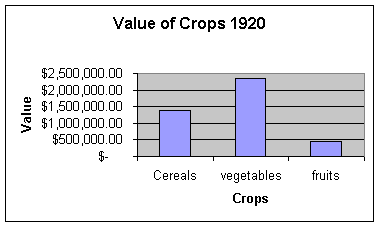
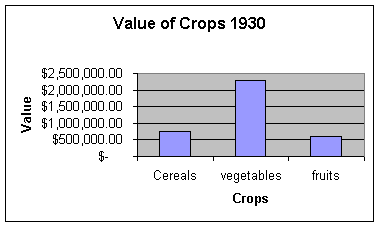

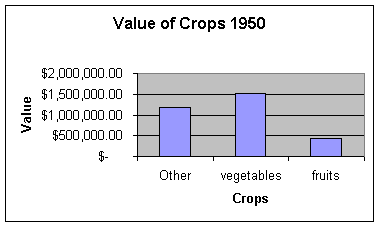
All tables derived from the US Census data,
1910-1950.[xii]
By
looking at these graphs it is visible that canning had a huge impact on Wicomico
County agriculture. Also from the
graphs it is observable that vegetables are of the highest value to Wicomico
County in 1920 and then the value stays steadily high though 1950. Although the value of the fruits and vegetables were on the
rise the actually canneries did not seem to pop up all over the county until the
1920’s and even after the fall of the canning industry in Wicomico County one
could still see an active cannery until 1977.
With the 300 canneries on the
shore there was a huge demand for labor. When
canning was first coming to the shore population numbers were very small
compared to that of nearby Baltimore City.
According to the census of 1910 Wicomico Counties population was only
26,815, which hardly matched the population of Baltimore City, 558,485.[xiii]
The county needed people to come work at the factories, and the city did
not have many jobs to offer, so it was a deal on both ends.
People that came to the shore came for opportunity, to support their
families for the coming year.
Working
at the canneries was not easy work, but many families endured it.
In the early years of the canning industry families would travel from
around the area and nearby Baltimore City to find temporary work in the summer
months. Women and children made up
most of the Eastern Shore canning work force.
Men would stay in the cities while their wives came to the Shore to get
some extra income. These conditions
were only seen in some of the canneries. According
to the Commissioner of Labor and Statistics in 1929 a study of 34 Eastern Shore
Canneries were researched. Of the
thirty-four only fourteen used migratory labor[xiv],
the remainder used local labor mostly local African Americans.
The Commissioner of Labor and Statistics also mentions that “with the
exception of one group of Polish workers from Baltimore all of the migratory
workers were colored secured from Baltimore, the Eastern Shore of Maryland and
Virginia. This form of labor and
jobs was new to this area as in the past Wicomico County had been able to
survive off of the locals, as it was mostly a local market.
The
labor force was mostly that of women and children who endured the hot summer
labor to bring in extra money for the following year.
Older children received wages of their own; however it was not a
significant amount by far. In the
canneries, children could be found, working along side their mothers helping to
bring in an extra bit of money, but they were not supposed to be there. One woman remembered:
“I guess children
weren’t supposed to working because I remember when some one would holler
‘inspector coming’ all the kids would run out of the plant and start playing
with their toys until the inspector left.”[xv]
They might be working in the
fields or in the actual cannery, but either way it was hard hot work that no
child should have to do. The time
that this was going on was before the soon to be child labor laws.
This work that was being done on the Eastern Shore was not uncommon for
the times. Money was needed for all
people and it didn’t matter what family member was doing the work to get it.
The following comments come from a 1918 article out of the Washington
Post, proof those children were enduring too much at a young age.
“Out of 274 canneries in
Maryland and Virginia visited by inspectors of the Department of Labor, 1,094
children under 14 years of age were found to be at work.
Further investigation showed that the children who managed to escape
school laws were employed at vegetable canneries during the season just passed
and are being employed a large part of this year at irregular hours with
unsanitary and crowded camps as their homes.
As stated by inspectors, children between the ages of 7 and 16 years
could be found peeling tomatoes, husking corn and preparing other vegetables.
Those too small to reach the tables stood on boxes placed on wet and
slippery floors.”[xvi]
Women
and children took on the task of enduring long seasons, hot weather and bad
living and working conditions. The conditions however were not the same for
migratory working woman and local woman. The
migrants were living at the canneries; the locals had the opportunity to escape
for the night.
Life at the
Cannery
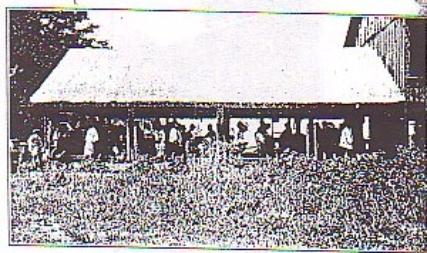
Image
1.[xvii]
A section of
living quarters that was used by thirteen families
Life at the canneries was far from perfect for the migrant workers who came to the area for the summer months. The housing conditions were primitive, they could be compared to the conditions that slaves lived in but this was by choice. In one account there was one shack for more than one family and one bathroom for thirteen families.[xviii] There was nothing provided for the one-room shacks and often time’s the beds were made of straw that the cannery provided. This account is from an interview of Prakseda Olympia Miskiel who worked at an Eastern Shore cannery after World War One. This account took place around 1921:
“A big truck would come,
filled with straw and we would make many trips with armfuls of straw and take it
to our shack and make our beds with it.” [xix]
If the living quarters did have beds it was often a
bunk that an entire family would share regardless of age.
There was no privacy in the living quarters.
This account is from a woman who worked at a cannery and gave this
interview to her son in 1986; she worked at the cannery in 1922.
“It was like a barn; they partitioned a big long barn
into parts. When you looked at it
from the outdoors- from a distance- it looked like a motel building, or like a
chicken house- a short, long building. Inside,
it was just one big space. Some
people would take blankets and make a partition, so that everybody else
couldn’t see then sleeping. Some
of the people would take trunks or boards and pile them up.
Others didn’t care if anybody saw that they were sleeping or not; they
just had their bunks of hay on the floor and put the blanket or sheet over the
top of the hay and just lay on it like that-like all outdoors.”[xx]
The lives of those who lived at the cannery camps was not a good life, however there were times when it was enjoyable. After the group would eat off their makeshift stove outside they would sit and talk, the children would play and in one account “Some men played would play the fiddle, some had accordions and we would dance and sing for hours”[xxi]. Although the long working days were long and hot in the early years of canning people made the most out of their summers. They were making money that could be used for the coming year.
Working
at a Cannery
Jobs
at a 1929 cannery ranged from being a peeler to being a person who spent the day
in the gruesome boiler room. The
jobs were all monotonous and most of the time required a lot of will power and
endurance. Being a peeler was a
common job for the women working at the canneries.
The few men that were at the canneries were usually in the boiler room,
or somewhere else in the cannery that required a lot of strength.
Being
a peeler meant that you were in constant dampness with tomato juice on the
floor. Often people wore rubber
boots and long rubber aprons.[xxii]
If you worked as a peeler the heat was also immense. The way that the
cannery was often set up was a two-story building with the peelers being on the
top floor. The cookers were usually
directly underneath. This meant that the steam coming from the boilers was coming
right up into the peeling room making the peelers suffer through unbearable hot
conditions.[xxiii] The months for canning
were in the summer when temperatures could often reach close to one hundred.
Payment as a peeler was the same as payment for any other job
in the cannery. In this account by
Prakseda Olympia Miskiel she talks about what is was like when she worked an
Eastern Shore peeling room in 1921.
“We
would peel the tomatoes and put them in a bucket and when it was full a man came
by, picked it up and took it to another part of the plant where the tomatoes
were canned. When he brought the
bucket back it had a token in it. Sometimes
the token was worth a nickel and one-year I remember it was worth 17 cents.
We really thought we hit it ‘big’ that year.” [xxiv]
This
amount of money at the time could buy lots of things.
According to Peg Rider, who worked at a Dorchester County cannery in 1932
claims that she bought her senior prom dress for one weeks wages at ten cents
and hour.[xxv]
The peeling room was where most of the
women and children worked. Imagine spending day in and day out surrounded by
tomato juice at a long table, peeling hot tomatoes, and making maybe a dollar a
day. It was horrendous work.
The job started before sun up with a break in the middle of the day and
lasted until nightfall, it was a ten-hour day six days a week.

Image
2.[xxvi]
Peelers
at work at a tomato cannery
Another job that women often had at the cannery was being a roller. Ms. Rider was a roller herself. She had to make sure that there were always cans rolling down to the fillers. If she did not do her job tomatoes would go all over the floor. It was hard work that required strength. She had to empty boxes to get the cans onto the belt, this meant being fast enough to pull out the cans and throw the box in the other direction. Lives and work for locals were often very different.[xxvii] However once the Depression hit even locals were finding that work at the canneries was necessary but not fun.
The
1930’s: Depression
Peg Rider worked at Neales Cannery in Hurlock Maryland in the summer of 1932 and 1933. She was fourteen years old when she worked at the cannery. She describes that the conditions were “hot and you were always covered in steam, but it was something you had to do, everyone needed work!”[xxviii] Peg Rider was working just to survive with the years of the depression underway I suspect that a lot of locals were using the canneries as a source of income.
Although the depression hit the country and a lot of people were coming to work on the Eastern Shore where the canneries were still very successful. A 1935 Washington Post article states that: “Wicomico County canneries are processing 40,000 bushels of tomatoes daily and giving seasonal employment to 1,600 persons”.[xxix] The canning industry helped to support those who were affected by the depression.
Canning
over the next decades
Through the 1940’s and 50’s the industry continued to thrive, proving that it was an industry that was meant for the area. With World War II came a labor shortage but the women and male farmers who stayed in the country helped the effort to send food to the troops. A 1944 Washington Post article states that “The State War Manpower Association will enlist the aid of Maryland white collar workers, housewives, and even entire communities in harvesting and processing food crops.”[xxx] In Fruitland The Dulany Cannery had been thriving for decades, having been asked to supply food during World War I, when World War II came around in the 1940’s Ralph Dulany was asked by request of the government to provide dehydrated foods rather than canned. The company later became the leader in dehydrated and frozen foods. World War II and instances like that of the Dulany Packing Co. foreshadow the end of the Wicomico County Canning Industry.[xxxi] Although the canning industry could foresee and ending there was still canning in Wicomico County and on the shore. A 1952 Daily Banner article titled Irish Eat Their Steaks From Locally Made Cans, describes the active can making company in Dorchester County.[xxxii] Another Daily Banner article from 1965 describes what seems like a desperate attempt to save the canneries: Canning Industry Spends of $600,000 For Improvements. [xxxiii]
The canning industry grew throughout the early twentieth century. During the First World War canned food items were a necessity because they could travel the long distance and remain unspoiled. This idea of canned foods keeping was the highlight for economics Wicomico County Agriculture until the late 1940’s. In 1930 the Wall Street Journal declared the “The Canning Outlook Good- All canning crops in Maryland have the prospect of being the best in several years. Indications are 1929 canned goods will be completely consumed before the new pack comes to the market.”[xxxiv]
The canning era brought about a new form of labor to the shore, migratory
labor. Migrants mixes with locals,
blacks mixed with whites, everyone came to work in the Wicomico County
canneries. Eventually industries such as frozen foods and then the broiler
chicken industry transformed Wicomico County Agriculture into a totally
different type of agricultural land. Canning
had impacts on society as well as the economy in Wicomico County Maryland.
The scars and successes of this time period are still felt by many.
[i] R. Lee Burton. Canneries of the Eastern Shore. (Centreville:Maryland, Tidewater Publishers, 1986)p.19.
[ii] Burton, p.25
[iii] Burton, p. 26
[iv] Burton, p.159
[v] Louis D. Harcum , Chapter IX: Farming (Salisbury: Penisula Press, 1981) p. 103
[vi] The Yearbook of Agriculture 1957 p. 620
[vii] Sam Geleta Salisbury University Doctor of Biology Personal Communication
[viii] Sam Geleta
[ix] Burton p. 42
[x]Burton p.160.
[xi] Burton, p.
[xii] 1910, 1920, 1930, 1940, 1950 US Census. http://fishe.lib.virginia.edu/collections/stats/histcensus (18 May 2004)
[xiii] 1920 Census. http://fishe.lib.virginia.edu/collections/stats/histcensus (18 May 2004)
[xiv] Anonymous, “Berry and Vegetable Pickers in Maryland Fields, Child Labor
InVegetable Canneries in Maryland” Commisioner of Labor and Statistics, MD. April 1929.
[xv] Interview with Prakseda Miskeil
[xvi] The Washington Post november 16 1918 Proquest Historical Newspapers The Washington Post pg. 6
[xvii] Anonymous, “Berry and Vegetable Pickers in Maryland Fields, Child Labor
InVegetable Canneries in Maryland” Commisioner of Labor and Statistics, MD. April 1929.
[xviii] Anonymous, “Berry and Vegetable Pickers in Maryland Fields, Child Labor
InVegetable Canneries in Maryland” Commisioner of Labor and Statistics, MD. April 1929.
[xix] Interview with Prakseda Miskeil
[xx] Interview with Stella Elizabeth
[xxi] Interview with Prakseda Miskeil
[xxii] Anonymous, “Berry and Vegetable Pickers in Maryland Fields, Child Labor
InVegetable Canneries in Maryland” Commisioner of Labor and Statistics, MD. April 1929.
[xxiii] Interview with Peg Rider, interviewed by author, Salisbury MD,,17 May 2004
[xxiv] Interview with Prakseda Miskiel
[xxv] Interview with Peg Rider
[xxvi] Anonymous, “Berry and Vegetable Pickers in Maryland Fields, Child Labor
InVegetable Canneries in Maryland” Commisioner of Labor and Statistics, MD. April 1929.
[xxvii] Interview with Peg Rider
[xxviii] Interview with Peg Rider
[xxix] The Washington Post August 22, 1935 Proquest Historical Newpapers The Washington Post p. 15
[xxx] The Washington Post April 4 1944 Proquest Historical Newspapers The Washington Post p. 3
[xxxi] Burton, p 155
[xxxii] Daily Banner 9 Feb 2952
[xxxiii] Daily Banner Aug 24 1965
[xxxiv] Wall Street Journal March 27, 1930 Proquest Historical Newspapers The Wall Street Journal p. 9